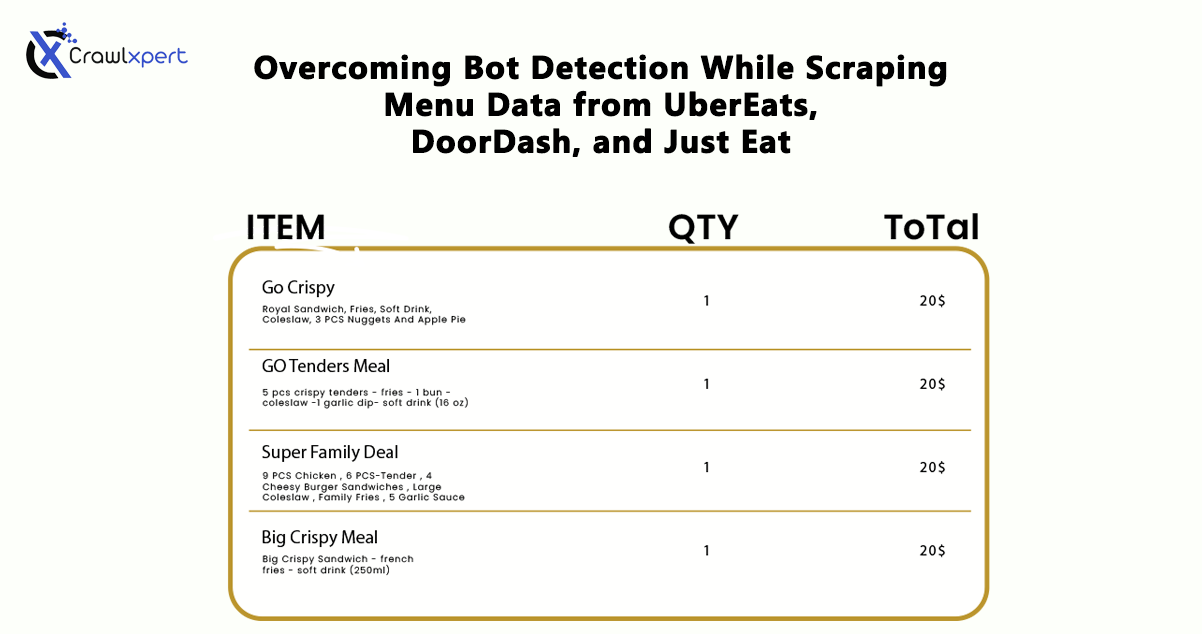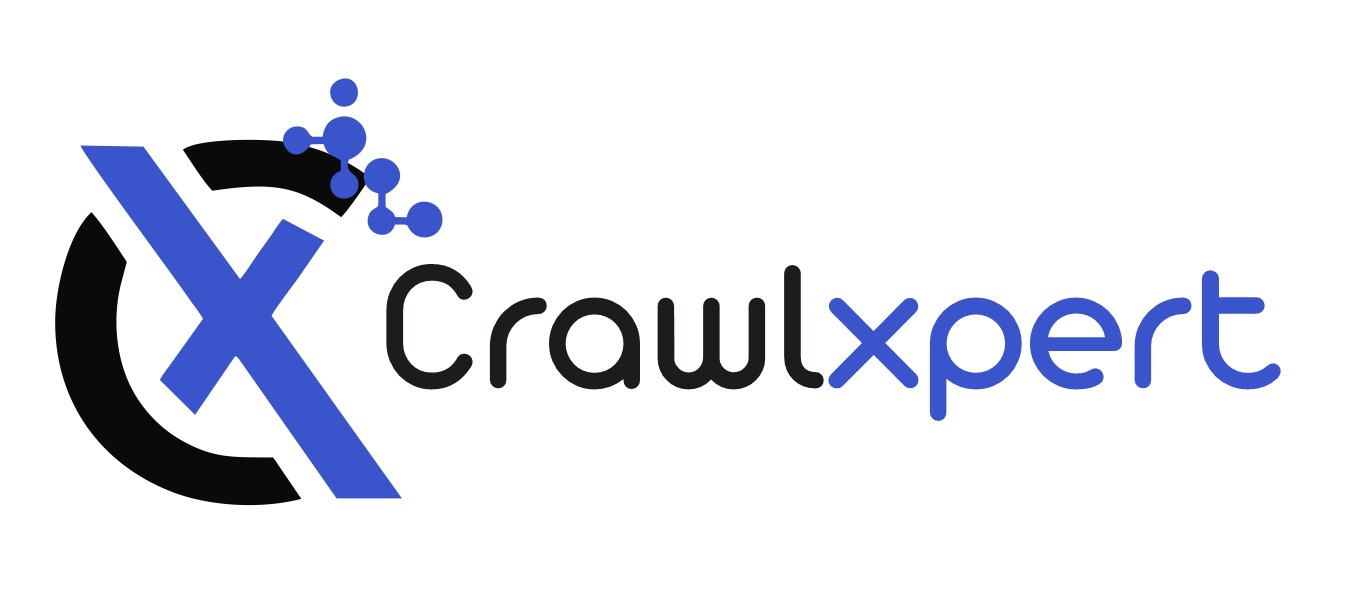
Overcoming Bot Detection While Scraping Menu Data from UberEats, DoorDash, and Just Eat
Apr 28, 2025
Introduction
In industries where menu data collection is concerned, web scraping would serve very well for us: UberEats, DoorDash, and Just Eat are the some examples. However, websites use very elaborate bot detection methods to stop the automated collection of information. In overcoming these factors, advanced scraping techniques would apply with huge relevance: rotating IPs, headless browsing, CAPTCHA solving, and AI methodology.
This guide will discuss how to bypass bot detection during menu data scraping and all challenges with the best practices for seamless and ethical data extraction.
Understanding Bot Detection on Food Delivery Platforms
1. Common Bot Detection Techniques
Food delivery platforms use various methods to block automated scrapers:
- IP Blocking – Detects repeated requests from the same IP and blocks access.
- User-Agent Tracking – Identifies and blocks non-human browsing patterns.
- CAPTCHA Challenges – Requires solving puzzles to verify human presence.
- JavaScript Challenges – Uses scripts to detect bots attempting to load pages without interaction.
- Behavioral Analysis – Tracks mouse movements, scrolling, and keystrokes to differentiate bots from humans.
2. Rate Limiting and Request Patterns
Platforms monitor the frequency of requests coming from a specific IP or user session. If a scraper makes too many requests within a short time frame, it triggers rate limiting, causing the scraper to receive 403 Forbidden or 429 Too Many Requests errors.
3. Device Fingerprinting
Many websites use sophisticated techniques to detect unique attributes of a browser and device. This includes screen resolution, installed plugins, and system fonts. If a scraper runs on a known bot signature, it gets flagged.
Techniques to Overcome Bot Detection
1. IP Rotation and Proxy Management
Using a pool of rotating IPs helps avoid detection and blocking.
- Use residential proxies instead of data center IPs.
- Rotate IPs with each request to simulate different users.
- Leverage proxy providers like Bright Data, ScraperAPI, and Smartproxy.
- Implement session-based IP switching to maintain persistence.
2. Mimic Human Browsing Behavior
To appear more human-like, scrapers should:
- Introduce random time delays between requests.
- Use headless browsers like Puppeteer or Playwright to simulate real interactions.
- Scroll pages and click elements programmatically to mimic real user behavior.
- Randomize mouse movements and keyboard inputs.
- Avoid loading pages at robotic speeds; introduce a natural browsing flow.
3. Bypassing CAPTCHA Challenges
- Implement automated CAPTCHA-solving services like 2Captcha, Anti-Captcha, or DeathByCaptcha.
- Use machine learning models to recognize and solve simple CAPTCHAs.
- Avoid triggering CAPTCHAs by limiting request frequency and mimicking human navigation.
- Employ AI-based CAPTCHA solvers that use pattern recognition to bypass common challenges.
4. Handling JavaScript-Rendered Content
- Use Selenium, Puppeteer, or Playwright to interact with JavaScript-heavy pages.
- Extract data directly from network requests instead of parsing the rendered HTML.
- Load pages dynamically to prevent detection through static scrapers.
- Emulate browser interactions by executing JavaScript code as real users would.
- Cache previously scraped data to minimize redundant requests.
5. API-Based Extraction (Where Possible)
Some food delivery platforms offer APIs to access menu data. If available:
- Check the official API documentation for pricing and access conditions.
- Use API keys responsibly and avoid exceeding rate limits.
- Combine API-based and web scraping approaches for optimal efficiency.
6. Using AI for Advanced Scraping
Machine learning models can help scrapers adapt to evolving anti-bot measures by:
- Detecting and avoiding honeypots designed to catch bots.
- Using natural language processing (NLP) to extract and categorize menu data efficiently.
- Predicting changes in website structure to maintain scraper functionality.
Best Practices for Ethical Web Scraping
While overcoming bot detection is necessary, ethical web scraping ensures compliance with legal and industry standards:
- Respect Robots.txt – Follow site policies on data access.
- Avoid Excessive Requests – Scrape efficiently to prevent server overload.
- Use Data Responsibly – Extracted data should be used for legitimate business insights only.
- Maintain Transparency – If possible, obtain permission before scraping sensitive data.
- Ensure Data Accuracy – Validate extracted data to avoid misleading information.
Challenges and Solutions for Long-Term Scraping Success
1. Managing Dynamic Website Changes
Food delivery platforms frequently update their website structure. Strategies to mitigate this include:
- Monitoring website changes with automated UI tests.
- Using XPath selectors instead of fixed HTML elements.
- Implementing fallback scraping techniques in case of site modifications.
2. Avoiding Account Bans and Detection
If scraping requires logging into an account, prevent bans by:
- Using multiple accounts to distribute request loads.
- Avoiding excessive logins from the same device or IP.
- Randomizing browser fingerprints using tools like Multilogin.
3. Cost Considerations for Large-Scale Scraping
Maintaining an advanced scraping infrastructure can be expensive. Cost optimization strategies include:
- Using serverless functions to run scrapers on demand.
- Choosing affordable proxy providers that balance performance and cost.
- Optimizing scraper efficiency to reduce unnecessary requests.
Future Trends in Web Scraping for Food Delivery Data
As web scraping evolves, new advancements are shaping how businesses collect menu data:
- AI-Powered Scrapers – Machine learning models will adapt more efficiently to website changes.
- Increased Use of APIs – Companies will increasingly rely on API access instead of web scraping.
- Stronger Anti-Scraping Technologies – Platforms will develop more advanced security measures.
- Ethical Scraping Frameworks – Legal guidelines and compliance measures will become more standardized.
Conclusion
Uber Eats, DoorDash, and Just Eat represent great challenges for menu data scraping, mainly due to their advanced bot detection systems. Nevertheless, if IP rotation, headless browsing, solutions to CAPTCHA, and JavaScript execution methodologies, augmented with AI tools, are applied, businesses can easily scrape valuable data without incurring the wrath of anti-scraping measures.
If you are an automated and reliable web scraper, CrawlXpert is the solution for you, which specializes in tools and services to extract menu data with efficiency while staying legally and ethically compliant. The right techniques, along with updates on recent trends in web scrapping, will keep the food delivery data collection effort successful long into the foreseeable future.

